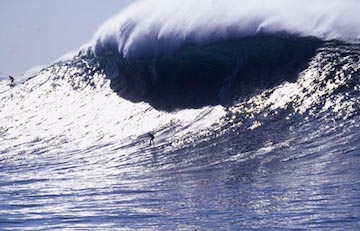large wave.jpg

Surfing on a big wave. Credit: National Oceanic and Atmospheric Administration
In late 2011, Hawaiian surfer Garrett McNamara took a thrilling ride -- or a chilling one, depending on your perspective. He surfed a wave as tall as a seven-story building. That earned him a spot in the Guinness Book of World Records. But both McNamara and another surfer say they’ve ridden even taller waves since then -- and at the same spot: near the village of Nazaré, Portugal.
Until the record-setting performance, Nazaré was little known. Since then, however, it’s become a magnet for big-time surfers and those who just want to be thrilled by the view.
The giant waves are created by a combination of factors that’s repeated in few other places. One of those factors is the weather. During winter, storms in the North Atlantic create big swells that head toward the coast. Along most of the coastline, they pile up as they reach shallower coastal waters, creating tall waves.
At Nazaré, though, the waves grow bigger than anywhere else along the coast. And that’s because of the second factor: the Nazaré Canyon. It’s the most dramatic submarine canyon in Europe. It begins about 125 miles offshore, at a depth of three miles, where it first cuts into the continental shelf. The V-shaped canyon gets narrower and shallower as it approaches the coastline. That makes it act like a funnel for ocean currents and for the storm-driven swells. That amplifies the swells and builds waves that might top out at a hundred feet or more -- creating massive thrills and chills on the Portuguese coast.

